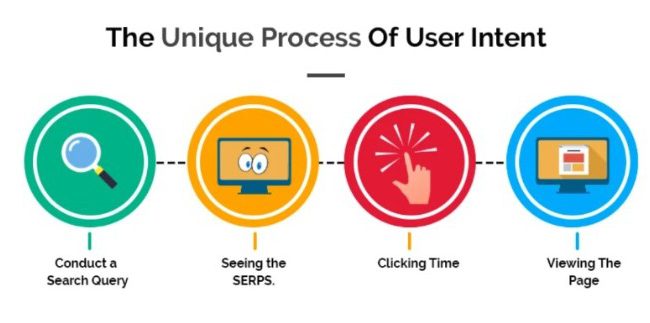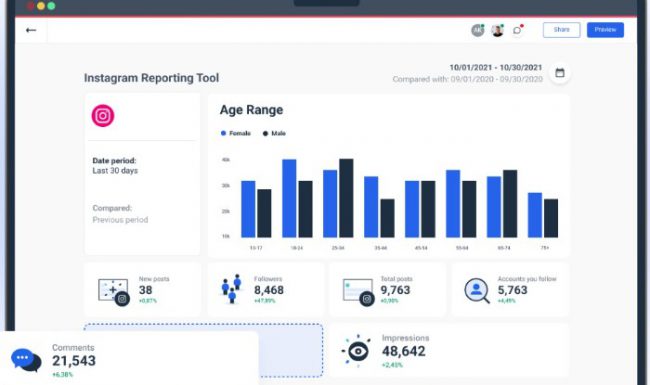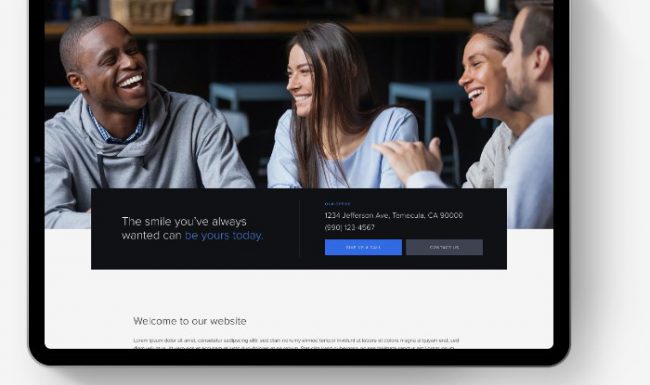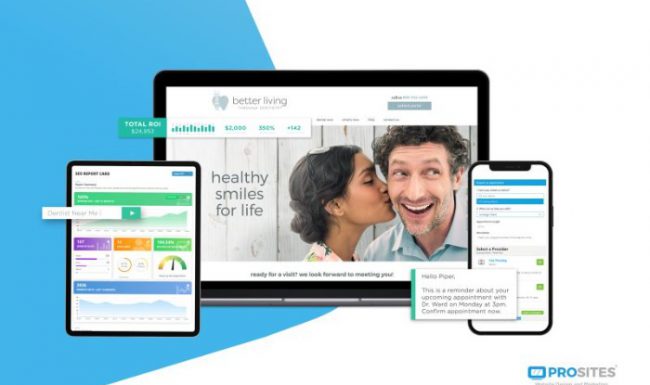Welcome to this guide on user intent for dental professionals! In this section, we’ll start by defining what user intent is and why it’s important for your dental marketing efforts. We’ll also cover the benefits of targeting user intent, so you can understand how it can positively impact your business.

Simply put, user intent refers to the purpose behind a user’s search query. When someone types something into a search engine like Google, they are trying to achieve something. For example, they might be looking for information, trying to solve a problem, or looking for a product or service to buy. Understanding user intent means understanding the motivation behind the search query.
Now that you know what user intent is, let’s talk about why it’s so important for dental professionals. By understanding the intent behind a user’s search query, you can tailor your content and marketing efforts to meet their needs. For example, if someone is searching for “teeth whitening near me”, you can create content that specifically addresses teeth whitening services and how your practice can help. This can increase the likelihood that the user will choose your practice over others.
Targeting user intent has several benefits, including:

To understand user intent, we must first understand search queries and keywords. In this section, we will cover the basics of search queries and the types of keywords that dental professionals should be aware of.
Search queries are the words or phrases that users type into search engines like Google in order to find information. Keywords, on the other hand, are the words or phrases that dental professionals use in their website content, blogs, and other online materials in order to rank higher in search results.
There are three main types of search queries that dental professionals should be aware of informational, navigational, and transactional.
Keyword research is the process of identifying the search queries and keywords that users are using to find dental services. By understanding the keywords that are relevant to your practice and your target audience, you can create content that is optimized for search engines and more likely to be found by potential patients.
Several tools can be used for keyword research, including Google Keyword Planner, SEMrush, and Ahrefs. These tools can help you identify the keywords that are most relevant to your practice and provide information on search volume, competition, and other metrics.
Overall, understanding search queries and keywords is a fundamental part of user intent and essential for dental professionals looking to optimize their online presence.

As a dental professional, understanding user intent is crucial for the success of your marketing efforts. In section 2, we discussed the basics of user intent and how it relates to search queries and keywords. In this section, we will dive deeper into how to identify user intent through search behavior.
One of the easiest ways to identify user intent is by analyzing Google search results and autocomplete. When users type in a query, Google provides a list of suggested searches, which can give insight into what users are looking for. Additionally, the search results that appear can indicate the type of intent behind the query.
For example, a search for “teeth whitening” may yield results for at-home whitening products, professional whitening services, or DIY remedies. By examining the search results and identifying patterns, you can determine what type of content would be most relevant to the user.
There are many tools and techniques available to help you understand user intent. One useful tool is Google Analytics, which can provide insights into the keywords and phrases users are using to find your website. This information can help you optimize your content to better align with user intent.
Another technique is to examine user behavior on your website. By analyzing which pages users are visiting and how long they stay on each page, you can gain a better understanding of what type of content is most engaging and relevant to them.
By identifying user intent through search behavior, you can create content that meets the needs of your audience and provides value to them.

When it comes to dental marketing, having a website that meets user intent is crucial. It’s not just about having a beautiful website but one that provides a seamless user experience, as that’s what Google rewards. User intent plays a vital role in both website design and SEO, and by targeting it correctly, you can improve your website’s ranking and attract more potential patients. In this section, we’ll discuss the importance of user-friendly website design, the role of user intent in SEO and ranking, and common SEO strategies for targeting user intent.
Importance of user-friendly website design: A user-friendly website design is critical for providing a good user experience. It’s essential to design your website in a way that makes it easy for visitors to find the information they’re looking for quickly. A website that is cluttered or confusing can lead to high bounce rates and lower rankings. Furthermore, if your website isn’t mobile-responsive, it can harm your SEO efforts as Google prioritizes mobile-friendly websites in their search results.
Role of user intent in SEO and ranking: Search engines, like Google, aim to provide the most relevant results to users based on their search query. Therefore, it’s crucial to understand user intent to optimize your website for search engines effectively. By creating content that matches user intent, you can increase your website’s relevance to search engines and improve its ranking.
Common SEO strategies for targeting user intent: One of the best ways to optimize your website for user intent is by creating high-quality, informative content that satisfies user needs. Keyword research plays a significant role in this process, as it helps you understand what users are searching for and the language they use. It’s essential to include keywords naturally in your content to improve its relevance and increase its chances of ranking.

As a dental professional, creating high-quality and relevant content for your website is crucial for attracting and retaining patients. However, it’s not enough to simply create content. You need to ensure that your content matches user intent, meaning that it fulfills the needs and desires of the users who are searching for it.
Here are some steps to creating content that matches user intent:
The first step in creating content that matches user intent is to identify content gaps. This means finding topics related to dentistry that people are searching for but that don’t currently have quality content available. One way to do this is to use keyword research tools like Google Keyword Planner or SEMrush to find popular search terms related to dentistry. Look for search terms with a high search volume and low competition.
For example, you might find that people are searching for “how to prevent cavities in children” but that there isn’t much quality content available on the topic. This could be an opportunity for you to create a comprehensive guide on preventing cavities in children.
Once you’ve identified content gaps, it’s time to create content that meets user intent. This means creating content that fully satisfies the needs and desires of the users who are searching for it. To do this, it’s important to understand the user’s search intent. Are they looking for information, products, or services? What questions do they have?
For example, if a user is searching for “dental implants,” they are likely looking for information about what dental implants are, how they work, and whether they are right for them. By creating a comprehensive guide to dental implants that answers these questions, you can create content that fully satisfies the user’s search intent.
Finally, there are several strategies for optimizing your content to better match user intent. One of the most important is to make sure that your content is easy to read and understand. Use simple language and break up long paragraphs into smaller chunks. Use headers and bullet points to make your content easy to scan.
Another strategy is to use multimedia to enhance your content. This could include images, videos, or infographics. Adding multimedia can make your content more engaging and easier to understand.
In addition, make sure that your content is well-organized and easy to navigate. Use a clear and consistent structure, and make it easy for users to find the information they need.
Overall, creating content that matches user intent is a crucial part of a successful dental practice website. By identifying content gaps, creating content that meets user intent, and optimizing your content for user experience, you can create a website that attracts and retains patients.

As a dental practice, you want to ensure that your advertising efforts are effective and reach the right audience. One way to do this is by targeting user intent through paid advertising. User intent plays a crucial role in determining the success of your ad campaigns.
In this section, we’ll discuss how to understand the role of user intent in paid advertising, choose the right ad format for targeting user intent, and optimize ad copy and targeting.
User intent is the primary reason why a user is searching.
Understanding user intent can help you create effective ads that are tailored to the user’s needs. When creating ads, it’s essential to consider the user’s intent and target your ad accordingly.
Different ad formats work best for different types of user intent.
For example, if a user is looking to schedule an appointment, a call-only ad that allows the user to call your practice directly from the ad would be most effective.
On the other hand, if the user is researching dental procedures, a search ad that directs the user to a relevant landing page would be more appropriate.
To create effective ads, you need to optimize your ad copy and targeting based on user intent.
Use keywords that match the user’s intent in your ad copy, and ensure that your targeting is relevant to the user’s search query. It’s also essential to test different ad variations to see which ones are the most effective at reaching your target audience.
When targeting user intent through paid advertising, it’s important to continuously monitor and adjust your ad campaigns to ensure that they are performing well.

Social media has become an integral part of people’s lives, and it can be a powerful tool for dental practices to understand and engage with user intent. In this section, we will discuss the role of social media in understanding user intent, strategies for using social media to understand user intent, and engaging with patients through social media.
Social media platforms such as Facebook, Instagram, Twitter, and LinkedIn can provide valuable insights into user intent. By analyzing social media data, dental practices can gain a better understanding of what their patients are interested in, what questions they have, and what challenges they face. This information can be used to tailor marketing campaigns and create content that resonates with the target audience.
For instance, dental practices can monitor the conversations on social media platforms to identify trending topics and common questions that patients have. This information can be used to create content that addresses these topics and answers the patient’s questions. Similarly, social media platforms can be used to gather feedback from patients and identify areas where improvements can be made.

To effectively use social media to understand user intent, dental practices should focus on the following strategies:
Social media can be a powerful tool for engaging with patients and building relationships. Here are some tips for engaging with patients through social media:
By using social media to understand and engage with user intent, dental practices can build stronger relationships with patients, increase brand loyalty, and ultimately drive more business.
Patient retention and referrals are crucial for the growth and success of any medical practice. Understanding user intent can help you develop strategies to improve patient retention and increase referrals.

User intent plays a significant role in patient retention and referrals. When patients visit a medical practice, they have certain expectations and goals in mind. Understanding their intent can help you meet their needs and exceed their expectations. By creating a positive patient experience, you can increase the chances of patient retention and referrals.
Overall, understanding user intent can help you develop targeted strategies to improve patient retention and increase referrals. By focusing on creating a positive patient experience and meeting patient needs, you can build a loyal patient base and grow your practice.

In today’s digital world, data and analytics play a crucial role in understanding user behavior and intent. As a healthcare provider, it’s essential to analyze user intent data to create better experiences for patients and improve overall healthcare outcomes.
Data and analytics provide valuable insights into patient behavior, preferences, and needs. By analyzing user intent data, healthcare providers can identify trends, understand patient needs, and tailor their services to meet those needs. This, in turn, can lead to improved patient outcomes and higher patient satisfaction rates.
There are several tools and techniques that healthcare providers can use to analyze user intent data. Some of these include:
In summary, data and analytics play a crucial role in understanding patient intent and behavior. By using tools and techniques such as Google Analytics, social media analytics, and surveys, healthcare providers can gain valuable insights into patient needs and tailor their services accordingly.

Marketing in the dental industry requires a deep understanding of user intent. With the right approach, you can create content and campaigns that not only attract potential patients but also convert them into loyal customers. In this section, we will cover the essential elements of user intent-driven dental marketing and best practices for targeting user intent in dental marketing.
User intent-driven dental marketing involves several elements that must be considered while designing a marketing campaign.
These elements are as follows:
Here are some best practices for targeting user intent in dental marketing:
By following these best practices, you can create a user-intent-driven dental marketing strategy that will help you attract and retain more patients.

Understanding user intent is crucial for successful dental marketing. Fortunately, there are many tools and resources available to help you analyze and target user intent. In this section, we’ll discuss some of the most recommended tools and resources for understanding user intent.
By using these tools and resources, you can gain a deeper understanding of user intent and tailor your dental marketing efforts to better meet their needs.

Here, we’ll cover some of the most common questions and concerns that dental professionals have about user intent and dental marketing. We’ll provide straightforward answers and solutions to help you better understand and target user intent in your dental marketing efforts.
Q. What is user intent in dental marketing?
A. User intent refers to the underlying motivation or goal that a person has when searching for dental services online. By understanding user intent, you can create targeted and personalized marketing campaigns that better meet the needs of your audience.
Q. Why is user intent important in dental marketing?
A. User intent is important because it allows you to create more effective marketing campaigns that are tailored to the specific needs and desires of your audience. By understanding what your potential patients are searching for online, you can create content and promotions that speak directly to them and increase the likelihood of converting them into actual patients.
Q. How do I identify user intent in dental marketing?
A. You can identify user intent by analyzing the keywords and phrases that people are searching for about dental services. There are a variety of tools and techniques available for analyzing user intent data, including keyword research, Google Analytics, and social media listening tools.
Q. What are some best practices for targeting user intent in dental marketing?
A. Some best practices for targeting user intent in dental marketing include creating targeted content that answers specific questions or addresses specific concerns that your potential patients may have, using data and analytics to inform your marketing strategy, and continuously refining your approach based on feedback and results.
Q. What are some common mistakes to avoid when targeting user intent in dental marketing?
A. Common mistakes to avoid when targeting user intent include assuming that all potential patients have the same needs and preferences, failing to regularly update and refine your marketing strategy, and neglecting to track and analyze the results of your campaigns.
We hope these answers provide clarity and insight into the world of user intent and dental marketing. By understanding user intent and following best practices, you can create more effective marketing campaigns and grow your dental practice.

Congratulations! You have made it to the end of this guide on understanding user intent for dental professionals. By now, you should have a clear understanding of what user intent is, how it relates to dental marketing, and how to target it effectively.
To summarize the key takeaways, here are some action steps you can take to put user intent into practice:
By incorporating user intent into your dental marketing strategies, you can create more meaningful connections with patients, improve your online visibility, and ultimately drive more business to your practice.
Thank you for taking the time to read this guide, and we wish you the best of luck in your dental marketing endeavors!